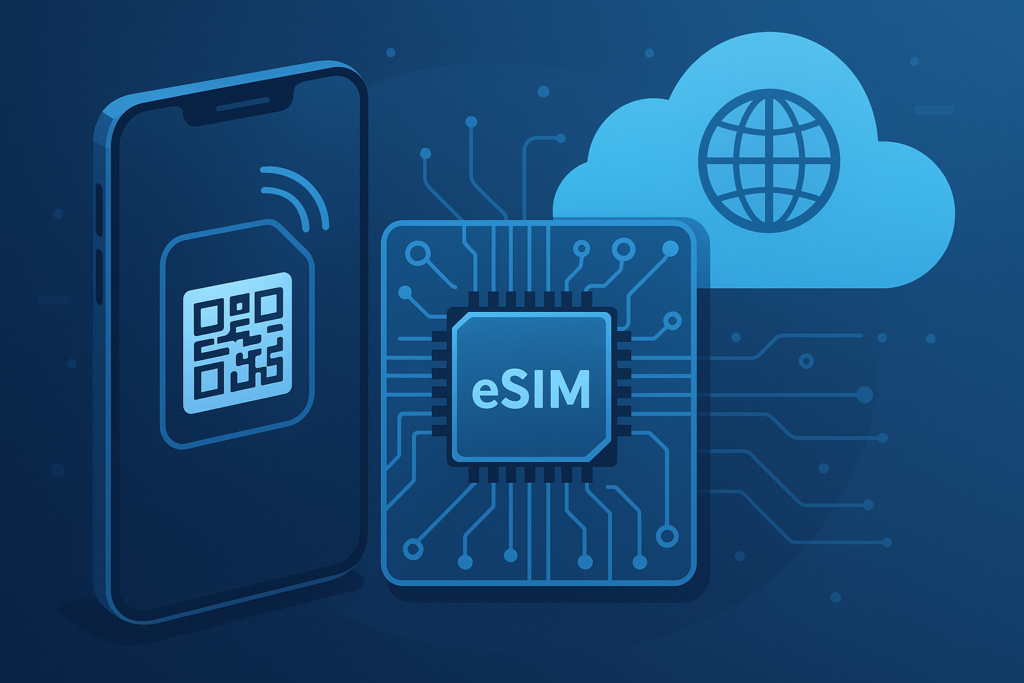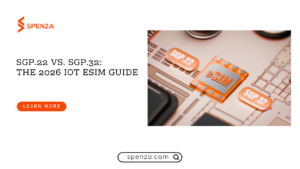
Table of Contents
- Introduction
- What is an eSIM-Only MVNO?
- The Advantages of the Digital-First Model
- Key Pillars for a Successful eSIM-Only Launch
- Spenza: Partner for Your eSIM-Only MVNO
- Use Case: An eSIM-Only MVNO for IoT Deployments – Bultr.io
- Conclusion: The Future of MVNOs is Digital
- FAQs
Introduction
Why would anyone still rely on physical SIM cards in 2025? With over 2.25 billion 5G subscribers projected this year alone, mobile service is entering a new era. Traditional telecom models built around physical logistics, like SIM card shipping and store activation, can’t keep up. Businesses need faster deployment, lower overhead, and greater control.
That’s where the eSIM-only MVNO model steps in. It removes all the slow parts. No physical cards. No shipping delays. Just pure eSIM connectivity delivered instantly through software.
In this blog, we explore how eSIM-only MVNOs work, why they matter now, and what it takes to start and scale one using a full-stack partner like Spenza. This post is your guide to building a lean, powerful mobile service brand for the digital age.
What Would You Get by the End of the Article?
- A full understanding of the eSIM-only MVNO model.
- Why this model is ideal for modern digital businesses.
- How to build a low-cost, high-efficiency mobile brand in 2025.
- The key components needed to succeed.
- Why Spenza is the right MVNE partner.
- How this model supports growth in both consumer and IoT spaces.
What is an eSIM-Only MVNO?
An eSIM-only MVNO is a mobile virtual network operator that works entirely on embedded SIM technology. There’s no physical SIM card involved. Customers activate plans using software, directly on their device.
This isn’t just a switch in technology. It’s a new mvno business model. To understand how eSIM is reshaping the MVNO model in 2025, read how eSIM is disrupting the MVNO market. Everything changes. There’s no inventory. No shipping. No handling costs. It becomes a service, not a product.
This type of MVNO is built for the modern digital user. It works better for frequent travelers, remote workforces, and IoT devices that need remote provisioning.
And in 2025, it’s not optional anymore. The market demands fast, scalable, cloud-driven solutions, and eSIM-only MVNOs deliver just that.
The Advantages of the Digital-First Model
As eSIM connectivity becomes more mainstream, digital-first MVNOs are no longer a nice-to-have. They are the only model that makes sense for a global, fast-moving tech business. These operators enjoy huge advantages in time-to-market, cost, scalability, and global access.

If you want to keep your network agile, your operations lean, and your user experience modern, this model is made for you.
Lower Costs Across the Board
Traditional SIM logistics are expensive and slow. eSIM-only MVNOs eliminate plastic SIM cards, reduce warehouse needs, and remove shipping processes. Everything runs in software. As a result:
- No packaging or postage.
- Lower support costs due to fewer physical errors.
- No delays in user onboarding.
- No need for inventory planning.
Costs don’t just drop, they become predictable. That’s key when scaling across geographies or serving thousands of devices. The billing and provisioning model becomes streamlined, all thanks to one eSIM management platform.
Activate From Anywhere
One of the best parts of digital-first networks is remote activation. No waiting. No stores. Just immediate onboarding through a mobile app. This helps users who move fast: frequent travelers, international employees, and remote workers. It also solves headaches for IoT businesses that need to activate devices in the field. You can push profiles to devices automatically. It reduces human error and allows quicker deployments at scale.
eSIM connectivity removes friction from the first experience. That’s what users expect in 2025. They want speed and control, not instruction manuals.
Simple, Central Control
With digital SIMs, centralizing control becomes easy. A dashboard can control the entire customer lifecycle. You can:
- Pause or cancel plans remotely.
- Monitor usage live.
- Update configurations for a group of devices at once.
For operations teams, this means no more jumping between systems. Your eSIM management tool does it all from one place. Technical teams get logs and diagnostics. Support teams can resolve tickets without asking the user to remove hardware. It’s simpler, smarter, and scalable.
Tailored for New Markets
Digital-first MVNOs are uniquely suited for niche audiences. Whether it’s a custom IoT mvno setup or international travel users, the model works. These use cases need zero-touch provisioning. No one wants to swap SIMs in a meter or smartwatch.
What makes it work:
- Profiles can be pushed based on region.
- Support for hundreds of device types.
- Flexible plan logic (e.g., daily or session-based).
The market now demands flexibility at launch and speed in growth. That’s what this model delivers. It lets you launch targeted MVNO services without hardware friction.
For niche segments like IoT and international plans, see how IoT MVNOs are powering automation in Industry 4.0.
Key Pillars for a Successful eSIM-Only Launch
Building a strong eSIM-only MVNO in 2025 takes more than vision. It requires selecting the right architecture, designing your tech stack with purpose, and ensuring your platform can scale in real time. Every piece, from your APIs to your user interface, must be built for performance, automation, and control.
Below are the core components that define a high-performing, digital-first MVNO setup:

1. A Scalable MVNO Platform
Your MVNO Platform must support instant provisioning, carrier switching, and plan configuration via APIs. Here’s a detailed guide to setting up an MVNO in 2025 with all the components you’ll need.This foundation helps reduce human errors and ensures tight integration between business logic and network functions.
2. A User-Friendly App
Your customer app is your retail store. It must support:
- eSIM download with QR scanning or auto-push.
- Plan upgrades, billing summaries, and usage alerts.
- In-app support via chatbot or ticket submission.
A good app makes switching networks or plans feel as easy as updating an app. It becomes the core user interface to your eSIM connectivity service.
3. Real-Time Analytics
Without analytics, you can’t optimize. A technical dashboard must support:
- Usage heatmaps by region and carrier.
- Alerts for unusual consumption patterns.
- Real-time fraud detection.
Access to precise network data in real time lets you improve service and catch problems before customers notice them.
4. Clear Branding and Marketing
Branding sets the tone. Digital-first MVNOs must:
- Target very specific groups (e.g., remote workers, IoT businesses).
- Highlight unique digital-first benefits (zero SIM, instant switch).
- Drive awareness through SEO, content, and targeted ads.
Your brand message must explain the why, not just the what, of your eSIM-only offer.
5. A Global Network Footprint
To offer true global eSIM connectivity:
- Your platform must integrate with multiple Tier-1 carriers.
- You must support fallback policies for roaming scenarios.
- You should allow users to switch carriers automatically when quality drops.
This flexibility is especially important for IoT MVNO deployments, where devices may operate across multiple borders with no manual intervention.
Spenza: Partner for Your eSIM-Only MVNO
A successful digital-first MVNO depends on the strength of its infrastructure. Spenza is a modern MVNE built from the ground up for cloud-native, eSIM-only deployments. The platform is API-first, meaning it integrates cleanly into your systems and workflows. It includes a complete suite of services: SIM and eSIM provisioning, billing, usage reporting, diagnostics, and multi-carrier control.
What makes Spenza different is its built-in scale. You can start small with a few thousand users and grow to millions, without changing your core tech stack. Everything updates through APIs, from activating a new user to switching carriers in real time. This allows you to control every element of your eSIM connectivity stack in one place.
For entrepreneurs asking how to start a MVNO, Spenza makes it fast and clean. And if you’re evaluating platforms, this breakdown of MVNE vs MVNA vs MNO will help clarify your best option.
You don’t deal with legacy telecom tools. You don’t wait weeks to go live. You set your brand and use Spenza to handle everything else, from global eSIM onboarding to complex usage-based billing.
Use Case: An eSIM-Only MVNO for IoT Deployments – Bultr.io
Let’s look at a real use case.
Bultr.io needed to deploy thousands of connected smart meters across 6 regions. They didn’t want to ship and manually install SIM cards.
They turned to Spenza. Using Spenza’s full eSIM management platform, they activated each meter as it was installed, remotely and automatically.
Here’s how it worked:
| Component | Challenge | Spenza’s Solution | Result |
|---|---|---|---|
| SIM Logistics | Manual SIM installs | Remote eSIM provisioning | Saved 60% ops cost |
| Billing | No usage-based pricing model | Custom billing engine | Accurate cost control |
| Connectivity | Needed global reach | 190+ carrier support | 100% coverage from day one |
| Scalability | Growing device network | Cloud-native API-first platform | Added 12,000 meters in 3 months |
They now run an efficient iot mvno with zero physical SIM cards and full digital control.
Conclusion: The Future of MVNOs is Digital
The eSIM-only mvno business model is the future. It’s faster to launch. It’s cheaper to run. It’s easier to scale.
If you’re a new brand or an IoT service provider, the question is no longer if you’ll switch to eSIM. It’s when.
If you’re serious about how to start a mvno in 2025, don’t build it alone. Spenza offers the platform and support you need to go live fast and grow globally. To build your own branded MVNO, explore how to launch your own eSIM marketplace using Spenza.
FAQs
They eliminate SIM shipping and allow remote activation, saving operational time and improving onboarding experiences for global users and connected devices.
Yes. Over 60% of smartphones shipping in 2025 are compatible with eSIM, making adoption faster and more practical for both users and providers.
With Spenza’s tools and APIs, you can deploy your MVNO service in just 48 hours, including provisioning and billing configuration.
Yes. Spenza’s infrastructure supports traditional mobile users and IoT mvno use cases with flexible eSIM provisioning and management options.
Spenza allows you to set billing logic, prepaid, postpaid, or usage-based, through an integrated engine tailored for MVNO operations.
Ready to build the future of mobile? Contact Spenza to explore our eSIM-only MVNO solutions.






